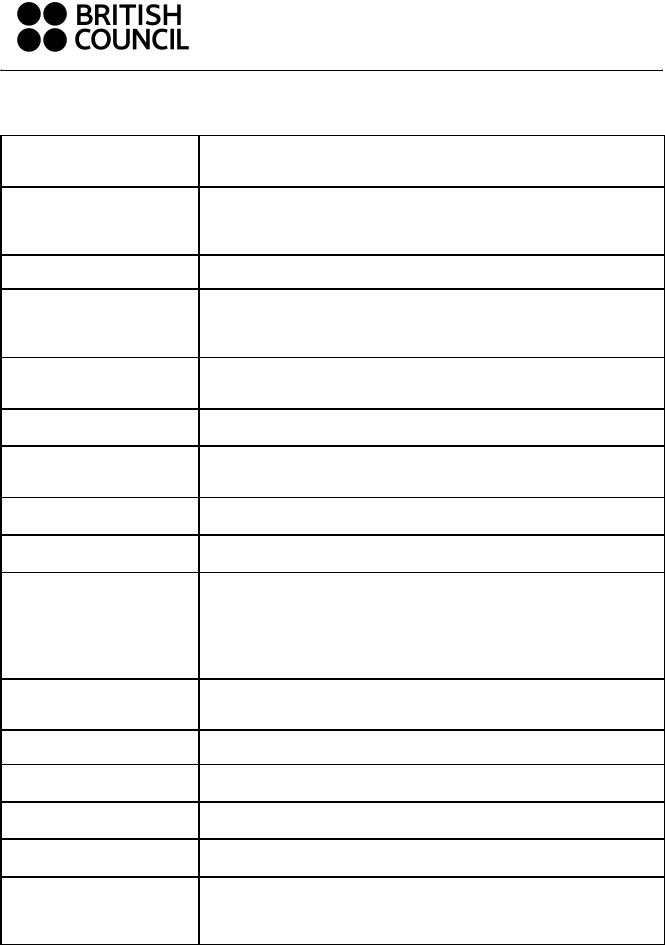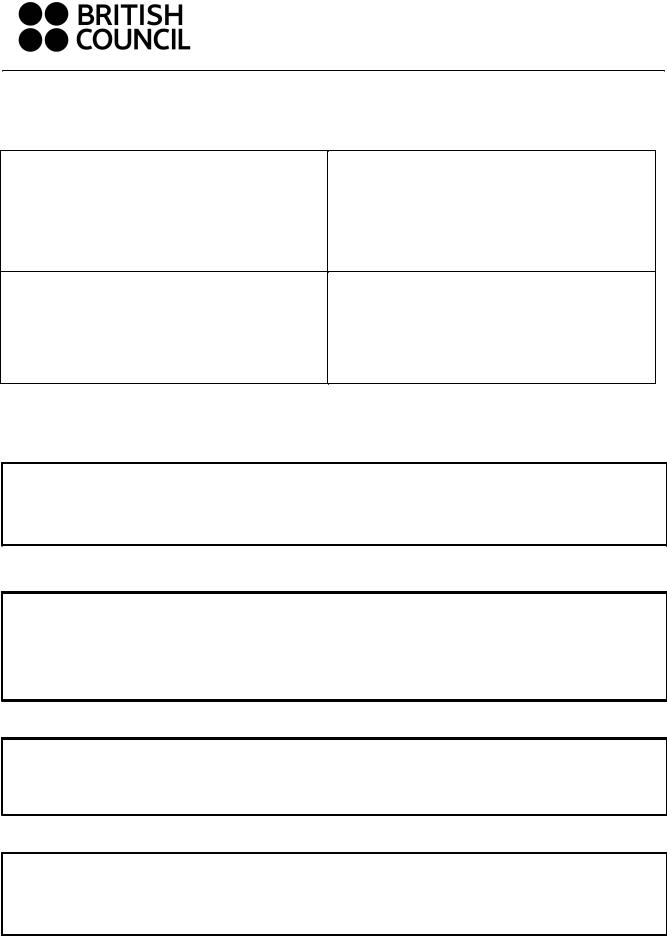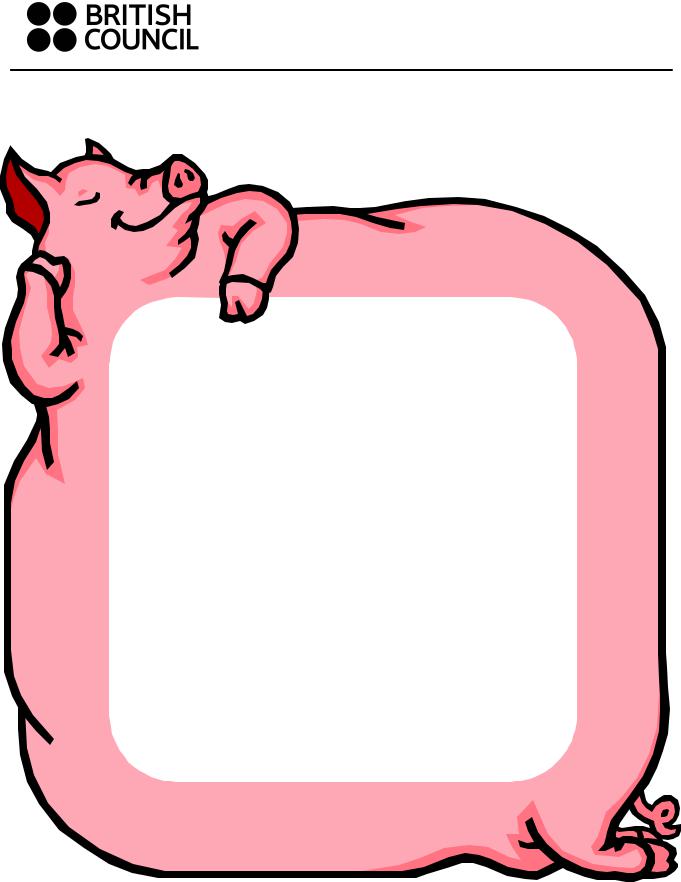
short_stories_2009-10
.pdf
Language Arts
Professional Development for Teachers
Learning English through Short Stories
|
Features of short stories – Matching Activity |
Opening |
the first few sentences, which usually arouse curiosity, pull the reader |
|
in and carry compressed information in short stories |
Exposition |
at the start of the story, the setting, situation and main characters up |
|
to now are introduced (though not used as much in short stories as in |
|
novels) |
Characterisation |
the process of creating and developing characters |
Plot |
a planned, logical series of events having a beginning, middle, and |
|
end. The short story usually has one plot so it can be read in one |
|
sitting |
Dialogue |
speech used for moving the story forward, though some dialogue can |
|
be redundant |
Narrative |
describes a sequence of events. |
Symbol |
an enhancement tool to stress the theme of a story, e.g. a dog can |
|
symbolise loyalty. |
Complication |
an event that introduces conflict. |
Rising action |
action that leads to a crisis. |
Conflict |
this is essential to a storyline Without conflict there is no plot. It is the |
|
opposition of forces which ties one incident to another and makes the |
|
plot move. Within a short story there may be only one central |
|
struggle, or there may be one dominant struggle with many minor |
|
ones. |
Climax |
the point of highest interest in terms of the conflict and the point of the |
|
story with the most action |
Falling action |
when events and complications begin to resolve themselves. |
Resolution |
the point of the story when the conflict is resolved. |
Twist |
an unexpected final paragraph which shatters readers' perceptions. |
Closing |
the last paragraph of the story. |
Moral |
the message conveyed or a lesson to be learned from a story – e.g. |
|
fairy stories often have a moral about distrusting people who appear |
|
to be trustworthy |
11
© The British Council
The United Kingdom’s international organisation for educational opportunities and cultural relations. We are registered in England as a charity.

Language Arts
Professional Development for Teachers
Learning English through Short Stories
NOTES:
The short story tends to be less complex than novels in structure, but its language tends to be more compressed. This can be very challenging for learners.
The short story may have a climax, crisis, or turning-point
The short story only occasionally it has an exposition
Typically, it has an abrupt OPENING with the story starting in the middle of the action
CLOSINGS (endings) may also be abrupt, have a twist, & do not necessarily have a moral or practical lesson.
These features will vary by author and by story
12
© The British Council
The United Kingdom’s international organisation for educational opportunities and cultural relations. We are registered in England as a charity.

Language Arts
Professional Development for Teachers
Learning English through Short Stories
Practical Demonstrations
The following pages provide copies of materials used in the practical demonstrations section. The assumption is that you can adapt and use similar activities with your learners of different levels of proficiency. We have also included some additional materials for your use.
By the end of the practical demonstration section you will have participated in activities and staging:
To increase students’ awareness of effective story openings
To develop learners’ ability to co-construct a story
To give practice in creating character, setting, dialogue.
Using chains of action and sequencing devices
Shaping ideas and creating first drafts
Openings
What Makes a Good Opening? Opening Writing Techniques
You will first look at some examples of openings to short stories and discuss/compare your ideas about what makes a good short story opening. You will match four openings with the technique that was used. You will be given frameworks for some story openings and will write your own opening.
Materials provided on Good Closings
These materials are not demonstrated in the training session due to time constraints.
Co-constructing a story
Providing whole class brainstorming at the start of a writing lesson on an area such as character, setting or plot can help generate ideas and language for students to use.
You could prompt this through something as simple as focusing on words starting with the same letter, in this lesson the letter ‘P’ or with a grid of topics to include in a story (handout)
It is important to allow for all students to add their ideas to the story so giving each student an area of responsibility to add to the story recipe can help prompt this. For example, one student decides on a character for the story, another student decides on a location, another student decides on some verbs to use in the story. The students in groups then make a story using as many of the ideas as possible.
Students may be able to build a story through telling it together in a whole class group and then write their individual version.
Students may build a story in small group orally and then write it together. You may want students to write a draft of the story together as their first draft. You will need to remind students that everyone needs to take part in the creating and writing so that the strong writer doesn’t take over.
Chains of Action
This is a technique to quickly generate plot ideas. They can be created individually, in small groups or as a whole class. They could be directly recorded as they are created or they could be written on to a worksheet.
13
© The British Council
The United Kingdom’s international organisation for educational opportunities and cultural relations. We are registered in England as a charity.

Language Arts
Professional Development for Teachers
Learning English through Short Stories
What makes a good ‘opening’?
a) Match the example story openings to the descriptions below (there is one extra description without an example opening). Not: You may have more than one possible answer for each.
A |
B |
Gregor woke up from a bad dream and |
‘Why is he here? Why has he come now? |
found he was transformed into a giant |
whispered a small voice. There was no |
insect. |
reply. |
Adapted from Franz Kafka’s Metamorphosis |
|
C |
D |
As Paul Chan stood in the middle of the |
|
shopping mall, all he could think of was |
The clock struck thirteen as the glass |
lying down and closing his eyes. |
smashed. They were inside. |
|
|
|
|
A Good Opening?
1.Dropping the reader into the middle of the dramatic action.
2.A quote or dialogue to make the reader ask questions – Who’s this? What are they saying? Why are they saying it?
3.A shocking statement – The telephone rang. He picked it up. The voice at the end told him to run. To run now. To not stop running.
4. ‘Mirror’ or ‘circular’ openings/closings – where each mirrors the other –. (opening) The young boy looked out of the window and wondered “What am I doing here?”
(Closing) The young boy looked out of the window and finally knew why he was there.
5. An intriguing opening that makes you wonder – Why? What’s happening here?
14
© The British Council
The United Kingdom’s international organisation for educational opportunities and cultural relations. We are registered in England as a charity.

Language Arts
Professional Development for Teachers
Learning English through Short Stories
b) The four story openings include one or more of the following important elements: character, time/place setting, event and dialogue. They have been annotated for you.
A |
|
B |
|
Gregor woke up in bed from a bad |
‘Why is he here? Why has he come |
||
night’s sleep and found he was |
|||
transformed into a giant insect. |
now?’ whispered |
a small voice. |
There was |
|
|||
Adapted from Franz Kafka’s Metamorphosis |
no reply. |
||
|
|
|
|
C |
|
D |
|
As Paul Chan stood in the middle of the |
The clock struck thirteen as the glass |
||
shopping mall, all he could think of was |
smashed. They were inside. |
||
lying down and closing his eyes. |
|
|
|
|
|
|
|
Orange = characters Blue = time/place setting Pink = event Green = dialogue
Now use the sentence frames to write four openings. A:
_______________ (who?) ______________________ (where?) and found ___________________
_________________________________________________________________________(what?)
B:
_______________ ______________________ ______________________(dialogue) whispered
___________________
_______________________________________________________________________(dialogue)
C:
As_______________ (who?) ______________________ (where?) all he could think of was
_________________________________________________________________________(what?)
D:
_________________________________________________________________(event?)________
______________________ (who?) were_________________________________________(what?)
What makes a good ‘closing’?
15
© The British Council
The United Kingdom’s international organisation for educational opportunities and cultural relations. We are registered in England as a charity.

Language Arts
Professional Development for Teachers
Learning English through Short Stories
a)Read the four statements about how a short story should end. With your group decide if you agree (ü) or disagree (X) with the statements.
b)Add one more piece of advice
A Good Closing?
1End with “…then s/he woke up and it was all a dream!”
2Make the reader always ask “What’s going to happen next?”
3.Answer all the questions that the reader has in the closing.
4.Use ‘frames’ – make your opening and closing scenes mirror each other.
Tips!
Circular opening / closings
Get students to write an opening based on a theme. Then ask them if they can close the story with the same opening words/phrases to bring their writing full circle.
Shared openings and closings
Get each student to give a classmate just the first line of something he or she has been working on. The classmate has to write something starting or ending with that line. This reduces the struggle of finding leads or endings.
Classifying openings and closings
Get students to classify the openings they write in a chart according to whether they contain dialogue, a shocking statement, a quote, or other categories they discover through reading. Use a second chart for endings, with categories such as summary statements, predictions, reflections about the events. Later, refer back to these charts to help students think about potential leads and endings.
Closings that don't work!
16
© The British Council
The United Kingdom’s international organisation for educational opportunities and cultural relations. We are registered in England as a charity.

Language Arts
Professional Development for Teachers
Learning English through Short Stories
∙Uninspired chronology: Students often make the error of just reverting to chronology, and ending their writing with the characters dying or falling asleep. If you ask students never to end their pieces with phrases such as "...and they all went to bed," you'll eliminate lots of dull conclusions. Why not make a light-hearted poster of banned short story phrases for your classroom?!
∙Catchall endings: As above, students use these when there are loose ends that they cannot tie up. In these instances, it is typical for students to conclude with passages such as, "It was all just a dream," or anything that provides an easy return from fantasy to reality. Discourage them from doing this.
References: http://teacher.scholastic.com/lessonrepro/lessonplans/instructor/power.htm#strategies http://www.primaryresources.co.uk/english/englishC1.htm (adaptable to secondary contexts)
17
© The British Council
The United Kingdom’s international organisation for educational opportunities and cultural relations. We are registered in England as a charity.

Language Arts
Professional Development for Teachers
Learning English through Short Stories
STORY-BUILD RECIPE CARDS
1- Write a description of the setting:
2- Write a description of a character he meets:
3- Write three things Percy says during this story:
4- Choose 5 verbs you can use in the story:
5- Choose 5 adjectives we have to use in the story:
6- Choose 3 objects that appear in the story:
18
© The British Council
The United Kingdom’s international organisation for educational opportunities and cultural relations. We are registered in England as a charity.

Language Arts
Professional Development for Teachers
Learning English through Short Stories
Write your story about Percy below.
19
© The British Council
The United Kingdom’s international organisation for educational opportunities and cultural relations. We are registered in England as a charity.

Language Arts
Professional Development for Teachers
Learning English through Short Stories
The Collaborative Storytelling Activity and the NSS English Language
Curriculum
action |
consequences |
Fortunately
Unfortunately
Write two more sentences for your story starting ‘Because…’
Because ………………….
Because…………………..
20
© The British Council
The United Kingdom’s international organisation for educational opportunities and cultural relations. We are registered in England as a charity.
